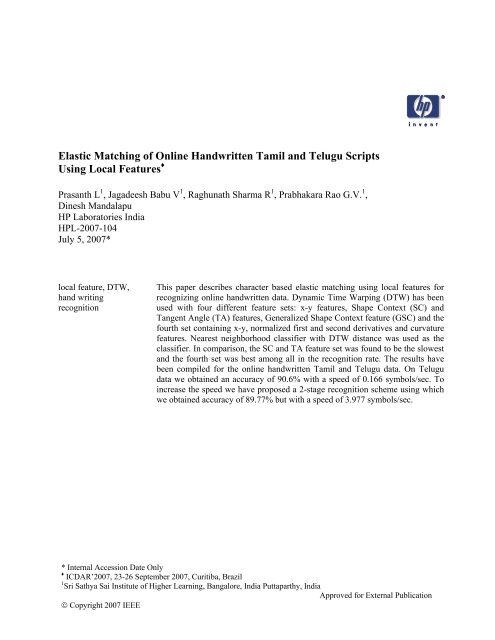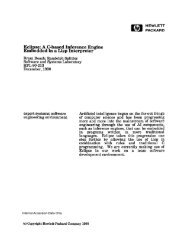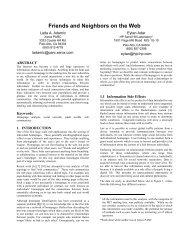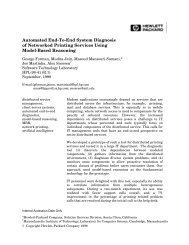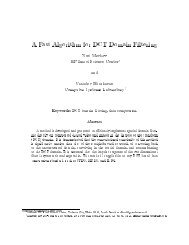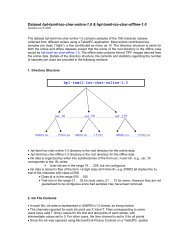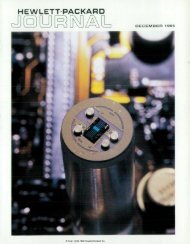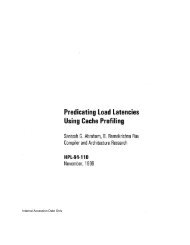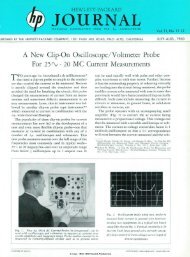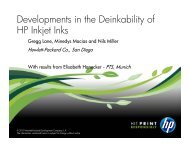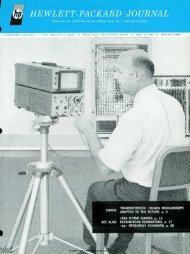Elastic Matching of Online Handwritten Tamil and Telugu - HP Labs ...
Elastic Matching of Online Handwritten Tamil and Telugu - HP Labs ...
Elastic Matching of Online Handwritten Tamil and Telugu - HP Labs ...
You also want an ePaper? Increase the reach of your titles
YUMPU automatically turns print PDFs into web optimized ePapers that Google loves.
<strong>Elastic</strong> <strong>Matching</strong> <strong>of</strong> <strong>Online</strong> <strong>H<strong>and</strong>written</strong> <strong>Tamil</strong> <strong>and</strong> <strong>Telugu</strong> Scripts<br />
Using Local Features ♦<br />
Prasanth L 1 , Jagadeesh Babu V 1 , Raghunath Sharma R 1 , Prabhakara Rao G.V. 1 ,<br />
Dinesh M<strong>and</strong>alapu<br />
<strong>HP</strong> Laboratories India<br />
<strong>HP</strong>L-2007-104<br />
July 5, 2007*<br />
local feature, DTW,<br />
h<strong>and</strong> writing<br />
recognition<br />
This paper describes character based elastic matching using local features for<br />
recognizing online h<strong>and</strong>written data. Dynamic Time Warping (DTW) has been<br />
used with four different feature sets: x-y features, Shape Context (SC) <strong>and</strong><br />
Tangent Angle (TA) features, Generalized Shape Context feature (GSC) <strong>and</strong> the<br />
fourth set containing x-y, normalized first <strong>and</strong> second derivatives <strong>and</strong> curvature<br />
features. Nearest neighborhood classifier with DTW distance was used as the<br />
classifier. In comparison, the SC <strong>and</strong> TA feature set was found to be the slowest<br />
<strong>and</strong> the fourth set was best among all in the recognition rate. The results have<br />
been compiled for the online h<strong>and</strong>written <strong>Tamil</strong> <strong>and</strong> <strong>Telugu</strong> data. On <strong>Telugu</strong><br />
data we obtained an accuracy <strong>of</strong> 90.6% with a speed <strong>of</strong> 0.166 symbols/sec. To<br />
increase the speed we have proposed a 2-stage recognition scheme using which<br />
we obtained accuracy <strong>of</strong> 89.77% but with a speed <strong>of</strong> 3.977 symbols/sec.<br />
* Internal Accession Date Only<br />
♦ ICDAR’2007, 23-26 September 2007, Curitiba, Brazil<br />
1 Sri Sathya Sai Institute <strong>of</strong> Higher Learning, Bangalore, India Puttaparthy, India<br />
Approved for External Publication<br />
© Copyright 2007 IEEE
<strong>Elastic</strong> <strong>Matching</strong> <strong>of</strong> <strong>Online</strong> <strong>H<strong>and</strong>written</strong> <strong>Tamil</strong> <strong>and</strong> <strong>Telugu</strong> Scripts Using<br />
Local Features<br />
L.Prasanth,V.Jagadeesh Babu, R. Raghunath Sharma, Dinesh M<br />
G.V.Prabhakara Rao, Hewlett-Packard <strong>Labs</strong>,<br />
Sri Sathya Sai Institute <strong>of</strong> Higher Learning, Bangalore, India<br />
Puttaparthy, India<br />
Abstract<br />
This paper describes character based elastic<br />
matching using local features for recognizing online<br />
h<strong>and</strong>written data. Dynamic Time Warping (DTW) has<br />
been used with four different feature sets: x-y features,<br />
Shape Context (SC) <strong>and</strong> Tangent Angle (TA) features,<br />
Generalized Shape Context feature (GSC) <strong>and</strong> the<br />
fourth set containing x-y, normalized first <strong>and</strong> second<br />
derivatives <strong>and</strong> curvature features. Nearest<br />
neighborhood classifier with DTW distance was used<br />
as the classifier. In comparison, the SC <strong>and</strong> TA feature<br />
set was found to be the slowest <strong>and</strong> the fourth set was<br />
best among all in the recognition rate. The results have<br />
been compiled for the online h<strong>and</strong>written <strong>Tamil</strong> <strong>and</strong><br />
<strong>Telugu</strong> data. On <strong>Telugu</strong> data we obtained an accuracy<br />
<strong>of</strong> 90.6% with a speed <strong>of</strong> 0.166 symbols/sec. To<br />
increase the speed we have proposed a 2-stage<br />
recognition scheme using which we obtained accuracy<br />
<strong>of</strong> 89.77% but with a speed <strong>of</strong> 3.977 symbols/sec.<br />
1. Introduction<br />
<strong>Online</strong> h<strong>and</strong>writing recognition is the recognition <strong>of</strong><br />
h<strong>and</strong>writing that is obtained from the movements <strong>of</strong><br />
the pen or a stylus when the writer writes on a penbased<br />
interface. For small devices like PDAs,<br />
Digitizing Tablets etc. the speed <strong>of</strong> recognition is an<br />
important factor. The online h<strong>and</strong>writing technology<br />
has a lot <strong>of</strong> potential in India that has more than<br />
eighteen <strong>of</strong>ficial languages. <strong>Tamil</strong> <strong>and</strong> <strong>Telugu</strong> are two<br />
major Indic scripts that have their origin in South<br />
India. While a lot <strong>of</strong> research is being done on online<br />
recognition <strong>of</strong> <strong>Tamil</strong> scripts, much research has not yet<br />
been done on online <strong>Telugu</strong> h<strong>and</strong>writing recognition.<br />
Both the scripts are complex from the point <strong>of</strong><br />
recognition as several symbols are structurally alike<br />
with minor differences. Hence, the recognition <strong>of</strong> these<br />
scripts using either template or elastic matching<br />
methods requires efficient features that are more<br />
discriminative at the local level.<br />
As discussed by Vuurpijl et.al. in [1], Dynamic<br />
Time Warping (DTW) is an elastic matching approach<br />
that has been observed to give better results than the<br />
WANDA system that uses HCLUS prototype matching<br />
techniques. In [2], the authors have reported writer<br />
dependent recognition <strong>of</strong> <strong>Tamil</strong> characters involving<br />
multiple stages that use DTW with x-y coordinates,<br />
quantized slopes <strong>and</strong> dominant points as features.<br />
Belongie et. al. [3] have used shape context feature<br />
with bipartite matching for finding the correspondence<br />
between boundary points <strong>of</strong> two shapes as part <strong>of</strong> their<br />
proposed method for object recognition. Shape<br />
signatures are functions that map the boundary points<br />
<strong>of</strong> a shape to a one-dimensional space. As described in<br />
[4] by Zhang & Lu, distance <strong>of</strong> the boundary point to<br />
the centroid <strong>of</strong> the shape, the tangent angle, curvature<br />
etc are examples <strong>of</strong> signatures. In [5] Tonouchi et.al.<br />
have proposed an algorithm in which they have used<br />
stroke length for matching the symbols stroke wise.<br />
Since the method was proposed for Japanese-Kanji<br />
characters, where the characters are made up <strong>of</strong> strokes<br />
that are very near to each other <strong>and</strong> are not as curvy as<br />
Indic scripts, stroke length feature was enough to<br />
match strokes between two different characters.<br />
In this paper we present the classification results on<br />
online <strong>Tamil</strong> <strong>and</strong> <strong>Telugu</strong> h<strong>and</strong>written data. The <strong>Tamil</strong><br />
data used is “<strong>HP</strong> <strong>Labs</strong> Isolated <strong>H<strong>and</strong>written</strong> <strong>Tamil</strong><br />
Character Dataset” [6] <strong>and</strong> the <strong>Telugu</strong> data set was<br />
collected by us. We use DTW distance in combination<br />
with the Nearest Neighbor classifier for recognition.<br />
Section 2 speaks about our data collection <strong>of</strong> <strong>Telugu</strong><br />
symbols. In section 3 we describe the preprocessing <strong>of</strong><br />
the online data followed by sections 3.1 to 3.7, in<br />
which we discuss the various local features that have<br />
been used for classification. Section 4 describes the<br />
DTW algorithm <strong>and</strong> the different combinations <strong>of</strong><br />
features used in the recognition. In Section 5 we<br />
present our results on <strong>Tamil</strong> <strong>and</strong> <strong>Telugu</strong> datasets <strong>and</strong><br />
also discuss a 2 stage recognition method. In Section 6<br />
we give concluding remarks about our work.
2. Data Collection<br />
2.1. <strong>Telugu</strong> Symbol Set<br />
<strong>Telugu</strong> is one <strong>of</strong> the major languages in India. The<br />
script contains syllables that are composed <strong>of</strong> vowels,<br />
consonants <strong>and</strong> their combinations. In a consonant–<br />
vowel combination, the vowels are orthographically<br />
indicated by signs called “matras”. The consonants,<br />
vowels, matras <strong>and</strong> consonant modifiers are included<br />
in the symbol set. Also included are some consonantvowel<br />
combinations which cannot be segmented. A<br />
symbol set containing 141 symbols, sufficient to cover<br />
the entire telugu script has been chosen for data<br />
collection. All the complete symbols that are a subset<br />
<strong>of</strong> the entire symbol set are shown in Figure.1.<br />
Figure 1: A subset <strong>of</strong> the collected <strong>Telugu</strong> character<br />
set<br />
2.2. Data Collection Tool<br />
We have used the Acecad Digital Notepad [7] for<br />
the purpose <strong>of</strong> collecting online h<strong>and</strong>written <strong>Telugu</strong><br />
symbols. Using a pen – paper based device such as the<br />
digital notepad, has made data collection more natural<br />
for the writers to give their input rather than using<br />
digitizers such as Tablet-PCs, where writers are<br />
expected to write on different surfaces that make the<br />
h<strong>and</strong>writing unnatural. The writers were provided with<br />
forms containing boxes printed on A5 sheets <strong>and</strong> were<br />
asked to write telugu symbols, one in each box, using<br />
the digital pen <strong>and</strong> pad. The ink from each <strong>of</strong> the<br />
boxes is extracted <strong>and</strong> stored in the UNIPEN format<br />
using a data collection tool that we developed for<br />
collecting data using the Digital Pad. <strong>Telugu</strong> data<br />
covering 141 unique symbols has been collected from<br />
143 writers with 2 trials per symbol by each writer.<br />
3. Local Features<br />
Local features are the features extracted at each<br />
point <strong>of</strong> the stroke. During preprocessing, the<br />
characters are uniformly re-sampled to 60 points,<br />
followed by normalization <strong>of</strong> both x <strong>and</strong> y coordinates<br />
to a range <strong>of</strong> [0-10]. Below, we define 8 different local<br />
features that have been used.<br />
3.1. Preprocessed x-y Feature<br />
The raw x <strong>and</strong> y coordinates are preprocessed as<br />
mentioned above, <strong>and</strong> the preprocessed xi <strong>and</strong> yi<br />
coordinates are used as the features at the point pi.<br />
3.2. Shape Context (SC) Feature<br />
The Shape Context feature has been proposed in [3]<br />
as a feature that is calculated at each point <strong>of</strong> the<br />
stroke. At every point the log <strong>of</strong> the distance <strong>of</strong> the<br />
point from rest <strong>of</strong> the points (r) <strong>and</strong> the slope angle <strong>of</strong><br />
the line joining the point to each <strong>of</strong> the points (θ ) are<br />
calculated. To make the feature scale invariant, the<br />
distances r are normalized by the mean distance.<br />
Finally at every point pi a histogram h<br />
i<br />
ˆ , built by<br />
dividing the log-polar space to bins with respect to r<br />
<strong>and</strong> θ, is given by<br />
k<br />
hˆ = # { q ≠ pi : k= rq*θq } (1)<br />
i<br />
where q is a point in the stroke, k is the bin number, rq<br />
<strong>and</strong> θq are the r <strong>and</strong> the θ bins <strong>of</strong> q respectively. The<br />
number <strong>of</strong> bins to be chosen is determined empirically.<br />
SC is a semi local feature which describes the relative<br />
position <strong>of</strong> the entire character with respect to the point<br />
<strong>of</strong> consideration. Since shape contexts are histograms,<br />
χ 2 distance is used for finding the distance between<br />
two points using shape context feature. Figure.2 gives<br />
a pictorial view <strong>of</strong> the shape context feature with 40<br />
bins at a point.<br />
3.3. Tangent Angle (TA) Feature<br />
At the point pi the slope <strong>of</strong> the tangent, θi, is<br />
calculated. The dissimilarity measure <strong>of</strong> the local<br />
tangent angles at two points pi <strong>and</strong> pj is calculated as<br />
0.5( 1-cos ( θi -θj ) )<br />
where θi <strong>and</strong> θj are the tangent angles at pi <strong>and</strong> pj<br />
respectively.
Figure 2: (Left) Distances from a point<br />
(highlighted) to rest <strong>of</strong> the points. (Right) Shape<br />
Context feature with 4 r-bins <strong>and</strong> 10 θ-bins at the<br />
point considered.<br />
3.4. Generalized Shape Context (GSC) Feature<br />
The Generalized Shape Context (GSC) feature has<br />
been proposed in [8] as an extension to the SC feature<br />
discussed above. In addition to the shape context<br />
feature, at every point pi, the unit length tangent that<br />
gives the direction <strong>of</strong> the edge at the point is<br />
calculated. The x <strong>and</strong> y components <strong>of</strong> this vector can<br />
be calculated by finding cos(θi) <strong>and</strong> sin(θi), where θi is<br />
the tangent angle at pi. The tangent vectors <strong>of</strong> all the<br />
points falling in a bin are added to the bin. The d-bin<br />
histogram is then converted to a 2d-dimensional vector<br />
vi ,<br />
x y x y d x d y<br />
vi= 〈 hˆ<br />
1, 1,<br />
2,<br />
2,<br />
, ,<br />
, hˆ<br />
, hˆ<br />
, hˆ<br />
,..., hˆ<br />
, hˆ<br />
〉 (2)<br />
i i i i i i<br />
k x<br />
where h<br />
i<br />
, ˆ <strong>and</strong> k y<br />
h<br />
i<br />
, ˆ are the x <strong>and</strong> y components <strong>of</strong><br />
k<br />
h<br />
i<br />
ˆ . Shape Context is a special case <strong>of</strong> GSC where the<br />
tangent angles are zero. L 2 norm has been used as a<br />
distance measure for GSC feature.<br />
3.5. Normalized Derivative Features<br />
Using the method given in [9] the normalized first<br />
derivatives with respect to x <strong>and</strong> y are calculated at<br />
each point pi as given below.<br />
∑ + − −<br />
r<br />
t.(<br />
x x )<br />
i t i t ∑ + −<br />
tt1<br />
=<br />
x′<br />
= i<br />
r<br />
2 t<br />
2<br />
−<br />
r<br />
t.(<br />
y y )<br />
i t i t<br />
t 1<br />
y′<br />
=<br />
(3)<br />
i<br />
r<br />
2.<br />
t<br />
2<br />
. ∑<br />
t = 1<br />
∑<br />
where r defines the number <strong>of</strong> neighboring points<br />
involved in the computation. We have taken r as 2. The<br />
normalized derivatives are given by<br />
xˆ<br />
′ =<br />
i<br />
x<br />
x′<br />
i<br />
2<br />
′ +<br />
i<br />
y′<br />
i<br />
2<br />
,<br />
yˆ<br />
′ =<br />
i<br />
x<br />
t=<br />
1<br />
y′<br />
i<br />
2<br />
′ +<br />
i<br />
y′<br />
i<br />
2<br />
(4)<br />
Similarly, the normalized second derivatives are<br />
calculated by substituting xi <strong>and</strong> yi with xˆ′ i <strong>and</strong> y′ ˆ in<br />
i<br />
the above equations. We have used both normalized<br />
first <strong>and</strong> second derivatives for classification.<br />
3.6. Curvature Feature<br />
For a plane curve, the curvature at a point pi has the<br />
magnitude equal to the reciprocal <strong>of</strong> the radius <strong>of</strong> an<br />
osculating circle (a circle that closely touches the curve<br />
at the given point). The curvature κi at point pi is<br />
calculated as<br />
κi =<br />
x′<br />
. y′<br />
′ − x ′′ . y′<br />
( ) 2 / 3 2 2<br />
x′<br />
+ y′<br />
(5)<br />
where x′, y′ <strong>and</strong> x′′ <strong>and</strong> y′′ are the normalized first <strong>and</strong><br />
second derivatives.<br />
4. <strong>Elastic</strong> <strong>Matching</strong> with Local Features<br />
4.1. Dynamic Time Warping<br />
For matching online h<strong>and</strong>written symbols the<br />
famous elastic matching algorithm, DTW has been<br />
used. It is a technique that finds optimal alignment<br />
between two time series if one time series may be<br />
warped non-linearly by stretching or shrinking it along<br />
its time axis. This warping between 2 time series can<br />
then be used to find the similarity between them. Let X<br />
<strong>and</strong> Y be two time series <strong>of</strong> lengths |X| <strong>and</strong> |Y| given by<br />
X = x1,x2,…….,xi,….,x|X|<br />
Y = y1,y2,……..,yi,…..y|Y|.<br />
A two dimensional cost matrix D <strong>of</strong> size |X| by |Y|<br />
is constructed where the value at D(i,j) is given by<br />
⎧D(<br />
i,<br />
j −1)<br />
⎪<br />
−<br />
⎪<br />
⎩D(<br />
i −1,<br />
j −1)<br />
D( i, j ) = min ( 1,<br />
) ( , )<br />
i i<br />
y x d<br />
⎨D<br />
i j + .<br />
(6)<br />
where the particular choice <strong>of</strong> the recurrence relation<br />
varies with the application <strong>and</strong> the distance function, d,<br />
depends on the features used. The DTW warp path is<br />
calculated starting at D(|X|,|Y|) <strong>and</strong> by backtracking<br />
the minimum cost index pairs. We have used the<br />
Sakoe-Chiba b<strong>and</strong> constraint, with 40 as the width <strong>of</strong><br />
the b<strong>and</strong>, to make DTW faster. For the purpose <strong>of</strong><br />
classification, DTW is used with varied sets <strong>of</strong> features<br />
that are given below.<br />
4.2. Different Sets <strong>of</strong> Features<br />
We have used 4 sets <strong>of</strong> features for<br />
experimentation. The first set consists <strong>of</strong> the x-y<br />
features alone. The next set consists <strong>of</strong> the SC feature<br />
combined with the TA feature. The third set contains
the GSC feature alone <strong>and</strong> the final set contains 7<br />
features viz. the preprocessed x-y features, the<br />
normalized first <strong>and</strong> second derivatives <strong>and</strong> the<br />
curvature. From now on we will call the set <strong>of</strong> 7 local<br />
features as the L7 features where L st<strong>and</strong>s for Local.<br />
Euclidean distance is used as the distance measure for<br />
the L7 feature set.<br />
5. Results <strong>and</strong> Discussion<br />
5.1. <strong>Tamil</strong> Data Set<br />
The <strong>Online</strong> h<strong>and</strong>written <strong>Tamil</strong> Data “hpl-tamiliwfhr06-train-online<br />
<strong>and</strong> “hpl-tamil-iwfhr06-testonline”<br />
[7], that covers 156 <strong>Tamil</strong> symbols, has been<br />
used for recognition. We call it the Competition Data<br />
set. The training <strong>and</strong> testing sets contain 50683 <strong>and</strong><br />
26926 samples respectively. We have used the training<br />
samples alone for our experimentation, out <strong>of</strong> which,<br />
40586 samples have been used for training <strong>and</strong> 4680<br />
for testing. We call this set as the Validation set. We<br />
have used the Nearest Neighborhood (NN) classifier<br />
that uses the DTW distance found between the test<br />
patterns <strong>and</strong> templates using different feature sets.<br />
5.2. Selection <strong>of</strong> Optimal Number <strong>of</strong> Bins<br />
We first consider SC <strong>and</strong> TA features for finding<br />
the optimal number <strong>of</strong> bins to be used. A combination<br />
<strong>of</strong> their respective distance measures, with weights 0.9<br />
<strong>and</strong> 0.1 respectively, is used as the cost measure. The<br />
same parameters have been used by Belongie.et.al[3]<br />
for the recognition <strong>of</strong> the MNIST data set <strong>of</strong> h<strong>and</strong>written<br />
digits for the calculation <strong>of</strong> the cost matrix.<br />
Table 1: Optimal Number <strong>of</strong> Bins for SC Feature<br />
Bins : r 3 3 3 4 4 5<br />
θ 6 8 12 8 10 12<br />
Accuracy 78.93 79 79.33 79 80.27 78.26<br />
For this purpose, 10 prototypes have been generated<br />
from the validation set <strong>and</strong> have been tested on the first<br />
10 symbols <strong>of</strong> the validation set. 40 bins have given<br />
optimal results as shown in Table1.<br />
5.3. Classification Results on <strong>Tamil</strong> Data<br />
In the case <strong>of</strong> GSC features also we have used 40<br />
bins. The DTW distance has been found using each <strong>of</strong><br />
the x-y, SC+TA, GSC <strong>and</strong> L7 features. The results are<br />
reported on all the 156 symbols from the validation set.<br />
50 prototypes have been used for training. Table 2<br />
shows the classification results using the 4 feature sets.<br />
The x-y features st<strong>and</strong> last in the recognition rate<br />
where as the L7 features have given best accuracy.<br />
From the point <strong>of</strong> recognition speed SC+TA are the<br />
slowest, while GSC are better than SC+TA in terms <strong>of</strong><br />
error rate <strong>and</strong> speed. x-y <strong>and</strong> L7 features are faster<br />
than the former 2 sets.<br />
Table 2: Recognition results on the Validation set<br />
with 50 prototypes with each <strong>of</strong> the feature sets.<br />
Feature Set Accuracies ( % ) Time<br />
Top1 Top2 (secs/symbol)<br />
X-Y 77.65 91.13 0.5<br />
SC + TA 79.08 92.98 240<br />
GSC 79.37 91 6<br />
L7 82.37 93.65 1<br />
The selection <strong>of</strong> prototypes also affects the<br />
recognition rate. Better results were obtained when<br />
tested with the prototypes selected using the same<br />
feature as those used for testing instead <strong>of</strong> the x-y<br />
features. In Table 2 we observe that the accuracy <strong>of</strong> L7<br />
feature set using normal prototyping method is<br />
82.37%. However, when trained with prototypes<br />
generated using the L7 features, the accuracy increased<br />
to 83.45%.<br />
Finally, using 50 prototypes, DTW with L7 features<br />
has given an accuracy <strong>of</strong> 82.34% on the Competition<br />
Data set.<br />
5.4 Classification Results on <strong>Telugu</strong> Data Set<br />
As mentioned in Section 2.2, out <strong>of</strong> the 38389 (after<br />
cleaning the totally collected 40326 samples) samples<br />
<strong>of</strong> <strong>Telugu</strong> symbols that have been collected, 29174<br />
have been used for training <strong>and</strong> 9215 for testing. Using<br />
the L7 features on this data set, with 50 prototypes, we<br />
have achieved an accuracy <strong>of</strong> 87.22%. We have also<br />
tested the telugu data set using DTW with both x-y <strong>and</strong><br />
L7 features without prototyping. Figure.3 shows the<br />
top 5 accuracies using x-y <strong>and</strong> L7 features without<br />
prototypes. 90.6 % is the top1 accuracy using L7<br />
feature <strong>and</strong> it has taken 6.024 seconds for recognizing<br />
one symbol.
Figure 3:Top 5 accuracies <strong>of</strong> DTW without<br />
prototypes using x-y <strong>and</strong> L7 features on <strong>Telugu</strong><br />
data.<br />
We also have considered recognition in two stages,<br />
where in the first stage we have selected only the best<br />
100 samples from the entire training set using NN<br />
classifier with Euclidean distance <strong>and</strong> in the second<br />
stage we have used NN classifier with DTW distance.<br />
In the second stage, only the 100 samples selected in<br />
the first stage have been used for matching. We have<br />
implemented the 2-stage recognition using x-y features<br />
<strong>and</strong> L7 features respectively. The accuracies over the<br />
entire 141 symbols are given in Table 3.<br />
Table 3: Results <strong>of</strong> Two-Stage recognition on<br />
<strong>Telugu</strong> Data Set.<br />
Feature Set Accuracy Time<br />
(%) (secs/symbol)<br />
X-Y 87.06 0.1778<br />
L7 89.77 0.2514<br />
6. Conclusions <strong>and</strong> Discussion<br />
We have compared the results <strong>of</strong> DTW with four<br />
different sets <strong>of</strong> features. We have used the <strong>Tamil</strong> data<br />
for experimentation. The SC <strong>and</strong> TA features are found<br />
to be slow since we have used χ 2 distance as a cost<br />
measure. GSC feature is better than SC+TA in terms <strong>of</strong><br />
accuracy <strong>and</strong> is 35 times faster than the latter. The L7<br />
were the best features in terms <strong>of</strong> speed <strong>and</strong> accuracy.<br />
On <strong>Telugu</strong> data we obtained an accuracy <strong>of</strong> 90.6%<br />
using DTW <strong>and</strong> the L7 features. We have used twostage<br />
recognition for <strong>Telugu</strong> symbols using NN<br />
classifier with Euclidean distance in the first stage <strong>and</strong><br />
the NN classifier with DTW distance in the second<br />
stage. It has given an accuracy <strong>of</strong> 89.77% <strong>and</strong> a speed<br />
<strong>of</strong> 4 symbols/sec using L7 features. In the case <strong>of</strong><br />
<strong>Telugu</strong> characters, even the L7 features were unable to<br />
distinguish several confusing pairs. The pairs<br />
<strong>and</strong> have been<br />
misclassified since we have not considered the pen up<br />
information. Few more examples <strong>of</strong> the misclassified<br />
pairs are that are structurally<br />
almost alike. This misclassification can also be avoided<br />
by using discriminative features, calculated at each<br />
point, that take into account the structure <strong>of</strong> the<br />
character around the point also.<br />
10. References<br />
[1] R.Niels <strong>and</strong> L.Vuurpijl, “Using Dynamic Time Warping<br />
for Intuitive H<strong>and</strong>writing Recognition”, Proc. <strong>of</strong> 12 th<br />
Conference <strong>of</strong> the International Graphonomics Society,<br />
Salerno, 2005, pp. 217-221.<br />
[2] Niranjan Joshi, G.Sita, A.G.Ramakrishnan, <strong>and</strong><br />
M.Sriganesh , “Comparison <strong>of</strong> <strong>Elastic</strong> <strong>Matching</strong> Algorithms<br />
for <strong>Online</strong> <strong>Tamil</strong> <strong>H<strong>and</strong>written</strong> Character Recognition”, Proc.<br />
<strong>of</strong> IWFHR-9, Tokyo, 2004, pp. 444-449.<br />
[3] S.Belongie, J.Malik, <strong>and</strong> J.Puzicha, “Shape <strong>Matching</strong> <strong>and</strong><br />
Object Recognition Using Shape Contexts”, IEEE Trans.<br />
Pattern Analysis <strong>and</strong> Machine Intelligence, Vol. 24, No. 4,<br />
April 2002, pp. 509-522.<br />
[4] D.Zhang <strong>and</strong> Goujun Lu, “Review <strong>of</strong> shape<br />
representation <strong>and</strong> description techniques”, Pattern<br />
Recognition , Vol. 37, No. 1, January 2004, pp. 1-19.<br />
[5] Y.Tonouchi <strong>and</strong> A.Kawamura, “An On-Line Character<br />
Recognition Method Using Length-Based Stroke<br />
Correspondence Algorithm”, Proc.<strong>of</strong> ICDAR’97, Germany,<br />
1997, pp. 633-636.<br />
[6] <strong>HP</strong> <strong>Labs</strong> Isolated <strong>H<strong>and</strong>written</strong> <strong>Tamil</strong> Character Dataset<br />
http://www.hpl.hp.com/india/research/penhw-interfaces-<br />
1linguistics.html<br />
[7]Acecad Digimemo Model A502<br />
http://www.acecad.com.tw/dma502.htm.<br />
[8] G.Mori, S.Belongie, <strong>and</strong> J.Malik, “Efficient Shape<br />
<strong>Matching</strong> Using Shape Contexts”, IEEE Trans. Pattern<br />
Analysis <strong>and</strong> Machine Intelligence, Vol. 27, No.11,<br />
November 2005, pp. 1832-1837.<br />
[9] M.Pastor, A. Toselli, <strong>and</strong> E.Vidal, “Writing Speed<br />
Normalization for On-Line <strong>H<strong>and</strong>written</strong> Text Recognition”,<br />
Proc. <strong>of</strong> ICDAR’05, Seoul, 2005, pp. 1131-1136.


